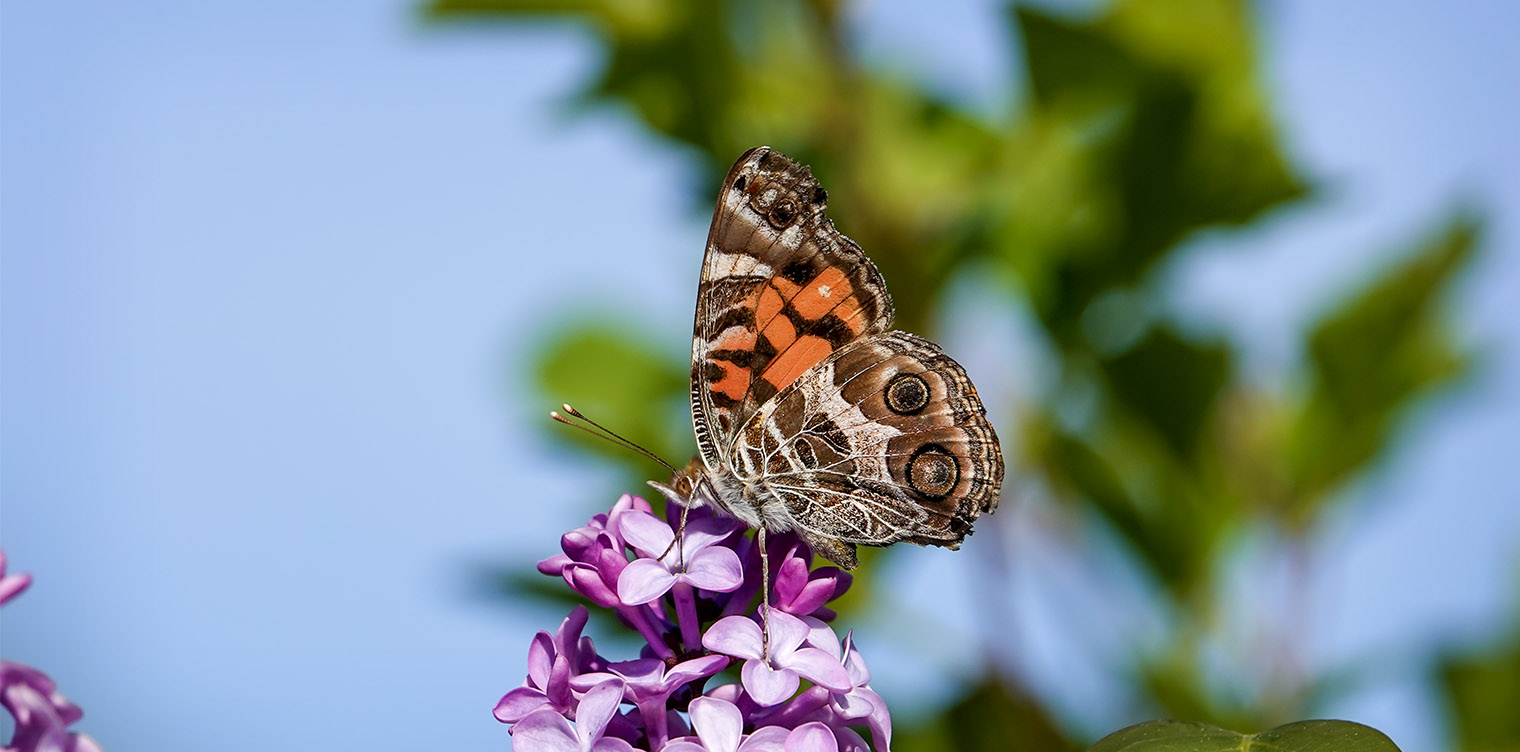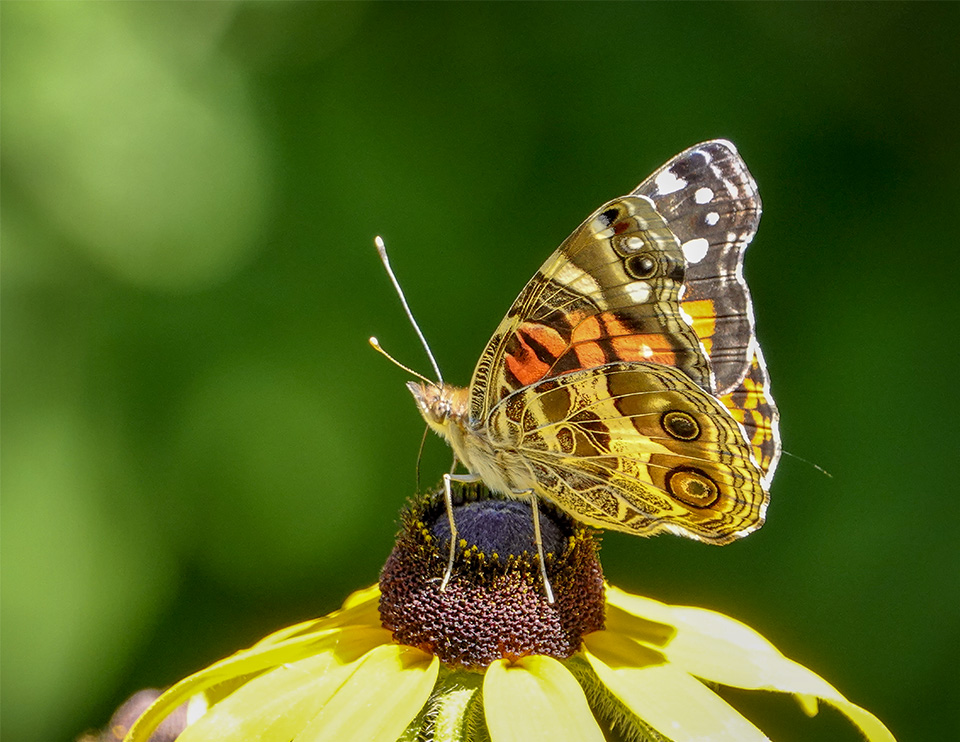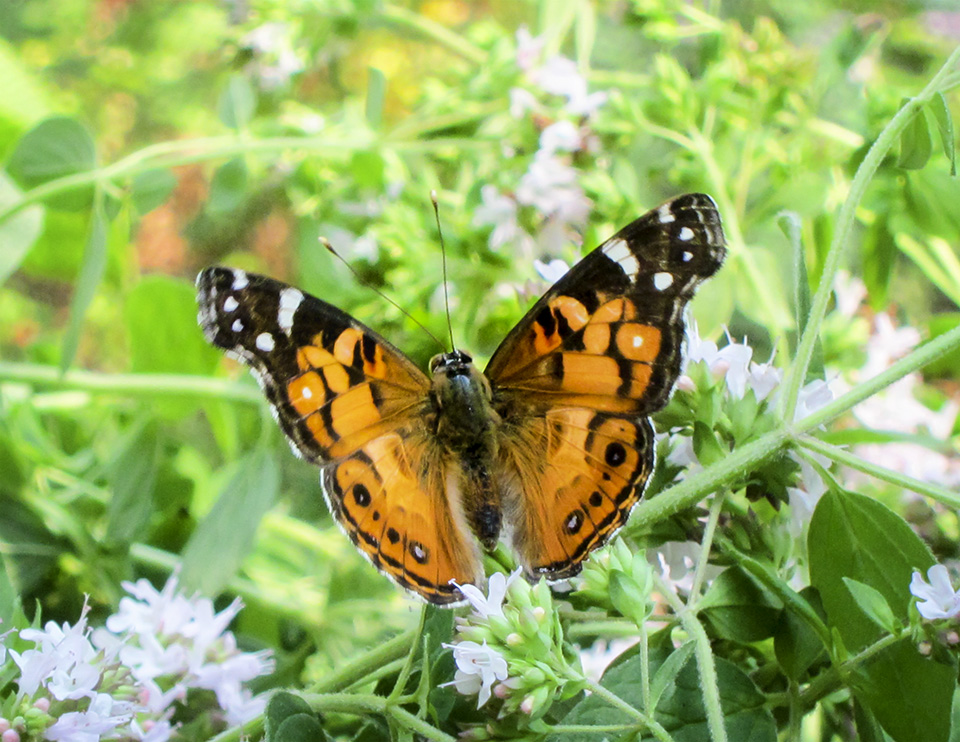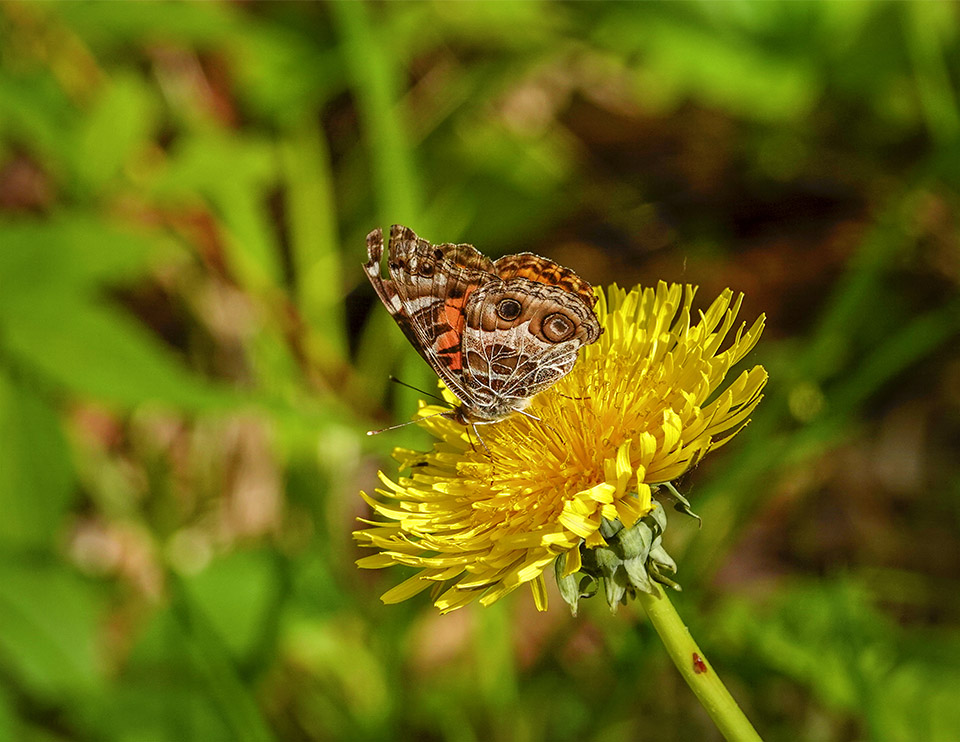Butterflies of the Adirondacks:
American Lady (Vanessa virginiensis)

The American Lady (Vanessa virginiensis) is a migratory butterfly that may be seen in the Adirondack Mountains in upstate New York during June, July, and August. It is a member of the Brushfoot Family. The species is named for Virginia. [1] This butterfly is also called the American Painted Lady, Hunter's Butterfly, and Virginia Lady. [2] [3]
The American Lady is a member of the Brushfoot family. [4] It is one of the Lady Butterflies, a group which also includes the Painted Lady and the Red Admiral. [5] [6]
American Lady: Identification

The American Lady is a medium-sized butterfly, about 1.75 to 2.125 inches in wing span. [7] Seen from above, it displays pinkish orange with black marks across the fore wing. [8] The tip of the fore wing has black marks.
The American Lady is quite similar in appearance to the Painted Lady. There are several differences which help differentiate the two species.
- The Painted Lady has more pointed wings.
- The American Lady usually has a small white spot in the orange cell by the upper wing margin, which helps distinguish it from the similar Painted Lady (Vanessa cardui). [9] [10] [11]
- The black median marks are usually not connected, in contrast to the slightly larger Painted Lady, whose black median band forms a semicircle. [12] [13]
- The underside of the American Lady has a complex pattern of olive, black and white, with two large blue eye spots near the outer margin on an olive field on the hind wing.[14] [15] The similar Painted Lady, by contrast, has four smallish eye-spots. [16]
American Lady: Life History

The American Lady is a fast-flying butterfly and often lights on flowers and other objects with its wings spread. [17] During the afternoon, males perch on hilltops or on low vegetation if there are no hills. [18] The butterflies spend a great deal of time on bare ground with their wings almost fully open.
American Ladies feed almost exclusively on flower nectar, including that of the pearly everlasting, dogbane, aster, goldenrod, marigold, and common milkweed. [19] The adult butterflies reportedly live from six to twenty days. [20]
The American Lady butterfly lays yellowish-green, barrel-shaped eggs singly. [21] [22] The resulting caterpillar is about 1.375 inches long and is black with yellow cross bands. [23] [24] [25] Caterpillar hosts include plants in the sunflower family, pearly everlasting, and ironweed. [26] [27] The insect forms a gold-spotted brown chrysalis about 22 mm long. [28]
American Lady: Habitat and Range
In terms of ecology, the American Lady is a generalist which is extremely widespread and adaptable. [29] This butterfly may be found in a wide variety of habitats, including roadsides, sunny open spots, gardens, old fields, meadows, forest clearings, and stream beds. [30] [31] [32] The American Lady is said to be more cold-tolerant than the Painted Lady. [33] [34]
Although some sources suggest that the American Lady is only occasionally migratory, [35] [36] most references indicate that the American Lady overwinters in the southern U.S. and then migrates north in the spring, [37] sometimes in large numbers. [38] Some southward migration in the fall has also been noted. [39] Its range extends from southern Canada southward to northern South America. [40] It is quite common in the eastern US, rarer in the West. The American Lady is seen occasionally in Europe, Hawaii, and the larger Caribbean islands. [41]
American Lady: Flight

The flight period for American Ladies in the New York City area of New York State is from late April to early October. They are most abundant around New York City in the first half of May and the first half of July. [42]
Although the American Lady's flight period in the Adirondack Park has not been established, two American Ladies were seen in nearby Bloomingdale Bog in late May 2012. [43] American Lady butterflies were present in 2012 in the Paul Smiths VIC Native Species Butterfly House and in the adjacent Butterfly Garden in July and August. [44] In 2017, American Ladies were seen in Bloomingdale Bog in early June; in 2019, they were seen at John Brown Farm in the second week in June.
It is not clear whether American Ladies from our part of the Adirondacks attempt a southward migration. Some may, but many others apparently die here in the Adirondack Mountains, to be replenished with others migrating from the south in the spring. [45]
References
- Susan Grimm Hanley. Interpretive Naturalist, Paul Smith's College Native Species Butterfly House. Species Logbooks.
- Butterflies and Moths of North America. Species Profiles. Confirmed sightings: 7/12/12; 7/30/12; 8/4/12; 8/11/12.
- Donald W. Hall. American lady, American painted lady, Vanessa virginiensis (Drury) (Insecta: Lepidoptera: Nymphalidae: Nymphalinae. Retrieved 9 October 2012.
- Government of Canada. Canadian Biodiversity Information Facility. SpeciesBank.
- Massachusetts Butterfly Club. Massachusetts Butterfly Species List.
- ENature. Field Guides.
- North American Butterfly Association. Sightings.
- Ross A. Layberry, Peter W. Hall, and J. Donald Lafontaine. The Butterflies of Canada (University of Toronto Press, 1998), p. 205, Plates 17, 21 and 26.
- National Audubon Society. Field Guide to Butterflies (New York: Alfred A. Knopf, 1981), pp. 623-624.
- Jim P. Brock and Kenn Kaufman. Kaufman Field Guide to Butterflies of North America (Houghton Mifflin, 2003), pp. 204-205.
- Paul A. Opler. A Field Guide to Eastern Butterflies (The Peterson Field Guide Series, Houghton Mifflin Company, 1992,1998), pp. 88-89, 269-271.
- Jeffrey Glassberg. Butterflies of North America (Michael Friedman Publishing, 2002), pp. 148-150.
- James A. Scott. The Butterflies of North America. A Natural History and Field Guide (Stanford University Press, 1986), p. 283.
- Donald and Lillian Stokes. Stokes Butterfly Book. The Complete Guide to Butterfly Gardening, Identification, and Behavior (Little, Brown and Company, 1991), pp. 72-75.
- Jeffrey Glassberg. Butterflies through Binoculars. The East. A Field Guide to the Butterflies of Eastern North America (Oxford University Press, 1999), p. 122, Plate 36.
- Paul A. Opler and George O. Krizek. Butterflies East of the Great Plains: An Illustrated Natural History (The Johns Hopkins University Press, 1984), pp. 158-159.
- Rick Cech and Guy Tudor. Butterflies of the East Coast. An Observer's Guide (Princeton University Press, 2005), p. 190.
- Thomas J. Allen, Jim P. Brock, and Jeffrey Glassberg. Caterpillars in the Field and Garden. A Field Guide to the Butterfly Caterpillars of North America (Oxford University Press, 2005), pp. 98-99.
